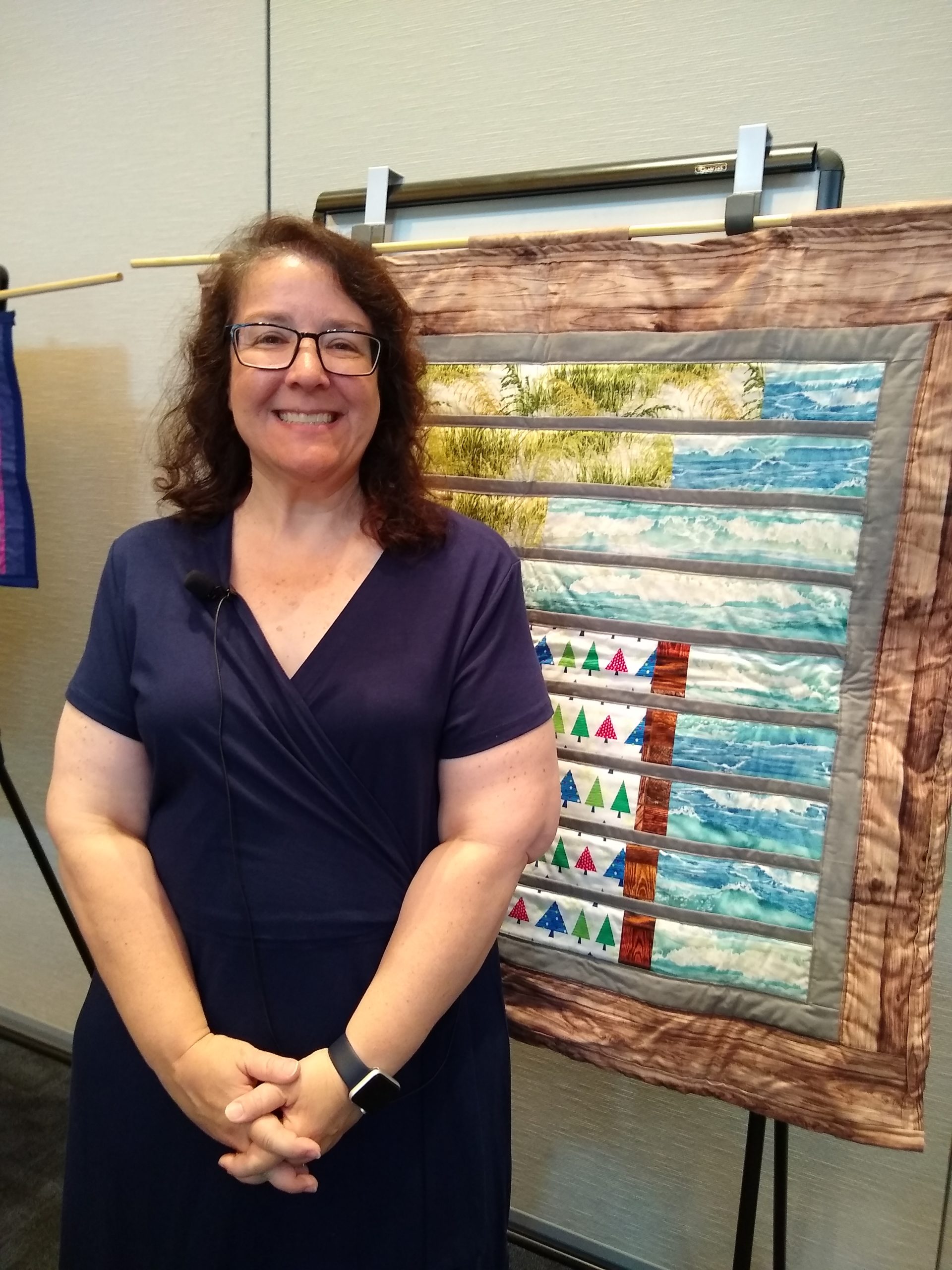
Sharing Stories of the Louisiana Coast Through Quilts
By Dr. Laura Guertin (NOAA Ship Thomas Jefferson, 2014)
I started quilting in 2006, creating blankets and wall hangings that I mostly gave away to friends and colleagues. But a trip to the southern Louisiana coast several years ago made a significant impact on the future direction and purpose of my quilting activities. Now, instead of quilting as a hobby, quilting has become a passion and tool that I use for science communication and education.
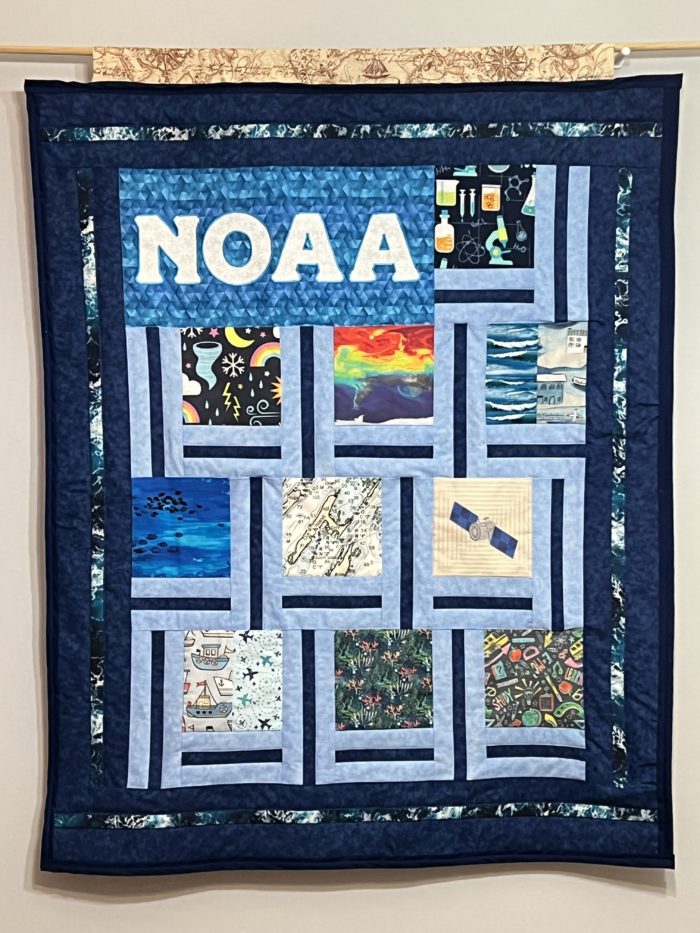
NOAA quilt completed in 2022, with each square of fabric representing the areas listed in the navigation menu of the NOAA website: research, weather, climate, ocean & coast, fisheries, charting, satellites, marine & aviation, sanctuaries, and education. Lear more about the quilt components in this video.
In March 2018, the Louisiana Universities Marine Consortium (LUMCON) invited a group of scientists and science communicators to their field station in Chauvin, LA, for an event titled OCEANDOTCOMM. I was a participant that joined this group for a week visiting field locations and engaging in conversations with local residents. I heard so many stories–but not the stories of “doom and gloom” that you would expect to hear in a region subjected to coastal subsidence, sea-level rise, extreme weather events, loss of vegetation, and more. Instead, we heard stories with positive outcomes, stories where there has been success in addressing these local challenges through a solutions approach. Instead of thinking that the obvious and only solution to living on the Louisiana coast is to retreat and relocate, we learned about the many reasons residents stay and the need to work in partnership across residents, scientists, and policymakers.
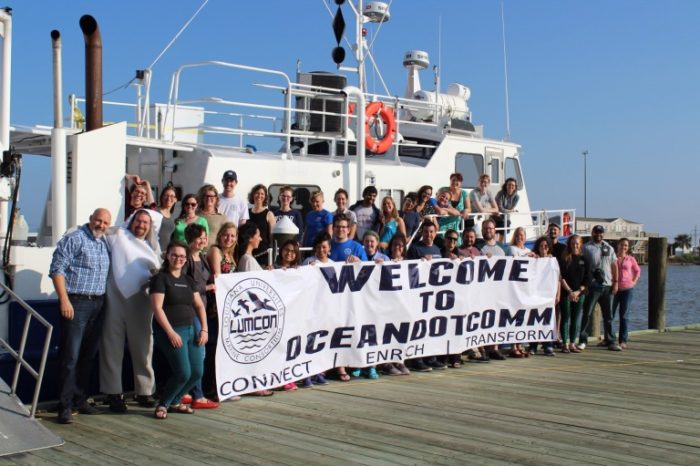
On the dock at LUMCON with the #odotcomm18 participants and LUMCON staff.
LUMCON’s Executive Director Dr. Craig McClain asked each of us to leave Louisiana and tell the stories of what we saw and learned, with the stories focusing on not what is being lost because of coastal change but share stories filled with “coastal optimism.” As an educator, I knew it would be easy to bring these stories into my classroom. And I have participated as a speaker in several science outreach events for non-STEM audiences, so I knew that would be another audience I could spread around some coastal optimism. But after spending time in Louisiana’s Terrebonne and Lafourche Parishes, exploring projects such as salt marsh restoration and hearing from the Pointe-au-Chien tribal community, I knew I wanted to challenge myself to find more ways to educate and communicate–but I had no idea which stories to start with, or which communication tools to use.
When my time at LUMCON concluded and I boarded my flight to head from New Orleans back to Philadelphia, the flight captain announced a weather delay in Philadelphia. As we were already seated with our seatbelts fastened, we needed to remain where we were to be prepared for takeoff soon as the weather cleared. At this point, I still have so many Louisiana coastal stories of adaptation and resilience swirling through my mind, and I have no idea which story I want to tell first.
My thoughts were interrupted by the passenger in the seat next to me, who started up a conversation. She was a local resident traveling north, and she asked me where I was from, what I was doing in Louisiana, etc. I explained to her what I was doing at LUMCON and the coastal optimism theme, and she immediately blurted out, “Christmas trees! Christmas trees are amazing!” I was immediately confused, and I’m sure I had a puzzled look on my face, because (a) it was the month of March, and (b) I had never mentioned Christmas trees! So I started looking up online how Jefferson Parish was using discarded Christmas trees as a tool to combat coastal erosion, and I knew this would be my first story to share!
Finally, after a long flight delay, I arrive home. I’m dragging my luggage into my house and walk through my dining room (which doubles as my quilting space) and see my sewing machine sitting on the table with an unfinished quilt project. I’m still not sure how or why, but a lightbulb when on for me at that moment. Maybe…just maybe…I could quilt a story of coastal optimism. I have crocheted science-themed items, such as temperature data in scarves, as do other crocheters/knitters through The Tempestry Project. And I have seen others create and share science-themed work, such as climate change scientist/artist Jill Pelto who uses scientific data as the basis for her work. But quilting a science story? I had never seen that done…so why not try?
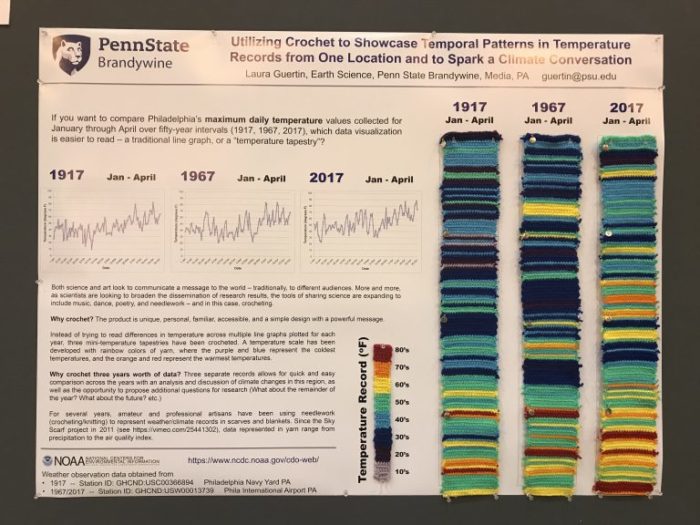
Poster presentation entitled “Utilizing Crochet to Showcase Temporal Patterns in Temperature Records from One Location and to Spark a Climate Conversation” for the 2017 AGU Fall Meeting
I started with the story of Christmas trees, thanks to the inspiration from my fellow airline passenger. I quickly realized that there is no quilt pattern for this type of story or for any of the stories I wanted to tell via quilting. I took my time figuring out how much I could include in the quilt and which fabrics could help with the storytelling. In the end, after two years, I generated a collection of nine quilts that I call Stitching Hope for the Louisiana Coast. Check out all of the quilts from this series in this video. Full quilt descriptions can be found on the Journeys of Dr. G Blog.
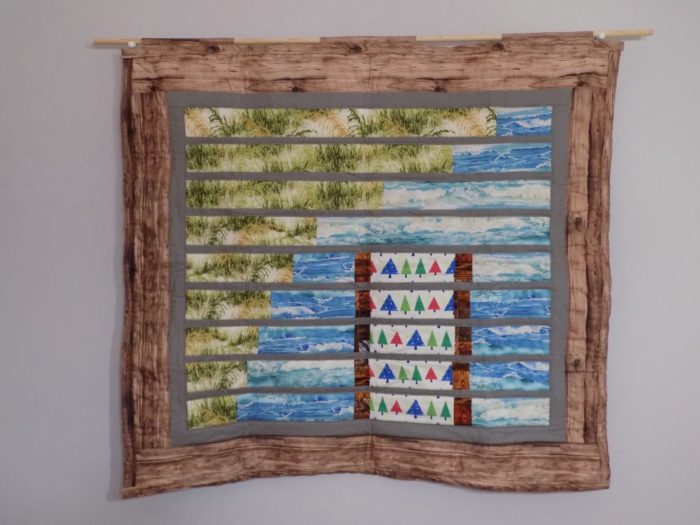
A chance conversation on a delayed flight home from LUMCON led to the creation of this quilt, when a local resident shared that her source of “coastal optimism” was the use of discarded Christmas trees.
I will admit, I was quite nervous when I began sharing these quilts. Would anyone view quilting as a serious tool for science storytelling? Fortunately, the quilts have been a success with scientists and non-scientists alike. I have found that people enjoy coming up and looking at a quilt, because everyone has their own quilt story! I have heard from so many people stories about their own parents or grandparents that made them a quilt, or stories about a blanket that adults have had since childhood. I didn’t realize the ability of a quilt to draw in an audience willing to listen to the story behind the quilt–and then (the best part!), share that story with others.
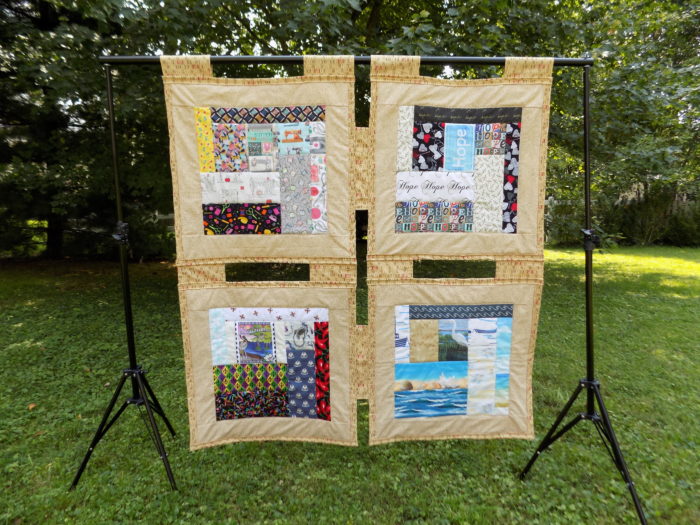
Introductory quilt to the Stitching Hope for the Louisiana Coast collection. The gaps between each panel represent the gaps we have in the science, in policy, in communication–and all are needed for us to find the solutions necessary for the coastal challenges of the present and future.
So many people have taken photos of my quilts and immediately shared the quilt and the story of coastal optimism with friends and family. I can educate and communicate in a way I never thought possible in my years of classroom teaching. Getting out in the field and spending time in a coastal community really helped me think outside the box and how I could engage with audiences I hadn’t had the opportunity to connect with in the past.
My journey into quilting science stories has continued. I have created a mini quilt collection of climate change solutions based on Project Drawdown sectors (Drawing Down Towards Climate Solutions). I co-organized an event for quilters of all ages and skill levels in 2021 called Quilt Your Science. And I look forward to more quilting adventures!
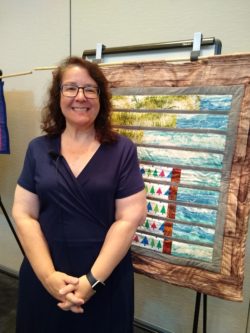 Dr. Laura Guertin is a Professor of Earth Science at Penn State Brandywine (Media, PA). She sailed as a Teacher at Sea in 2014 aboard the NOAA Ship Thomas Jefferson. She welcomes any questions on creative science communication at guertin@psu.edu. Photo credit: Mary Mark Ockerbloom, CC BY-SA 3.0/Wikimedia
Dr. Laura Guertin is a Professor of Earth Science at Penn State Brandywine (Media, PA). She sailed as a Teacher at Sea in 2014 aboard the NOAA Ship Thomas Jefferson. She welcomes any questions on creative science communication at guertin@psu.edu. Photo credit: Mary Mark Ockerbloom, CC BY-SA 3.0/Wikimedia
